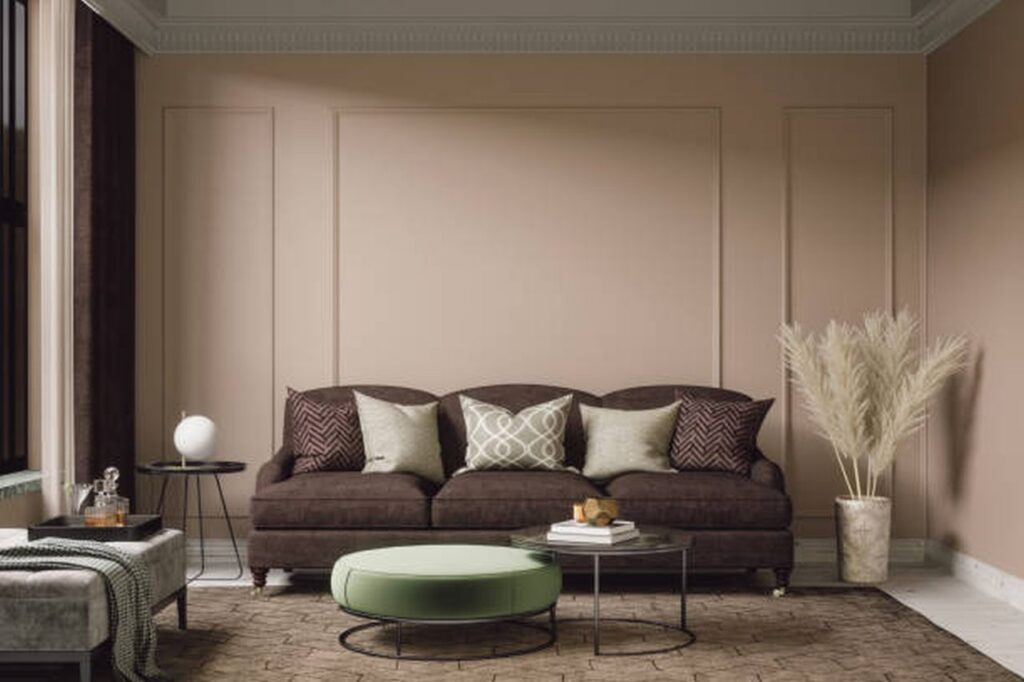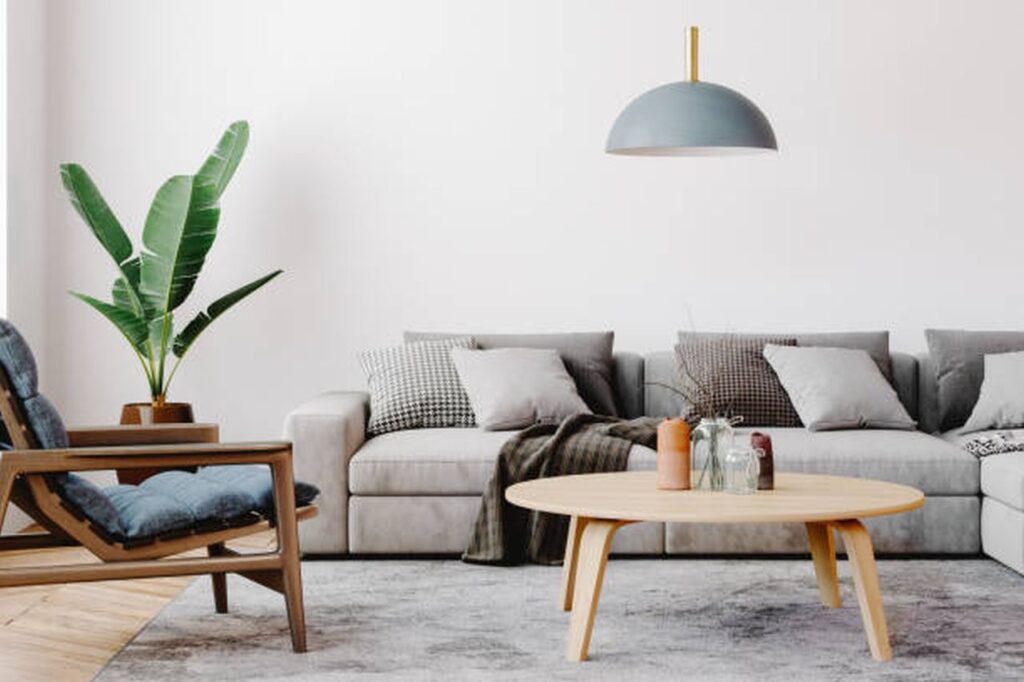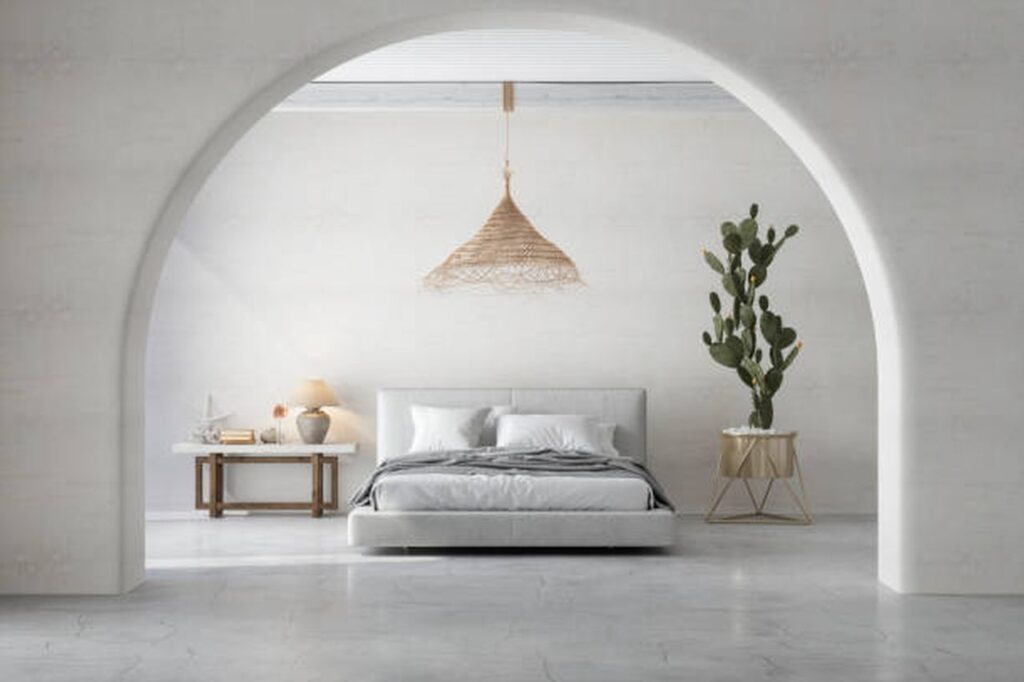Today, most people are familiar with the concept of Minimalism, which involves stripping things down to their most basic form. You can apply it to anything from art and lifestyles to architecture and interior design.
Minimalist interior design is similar to modern interior design and involves using the bare essentials to create a simple and uncluttered space. It’s characterised by simplicity, clean lines, and a monochromatic palette with colour used as an accent. It usually combines an open floor plan, lots of light, and functional furniture, and it focuses on the shape, colour and texture of just a handful of essential elements.
Elements Of Minimalist Design
Bare Essentials
The minimalist approach uses only the essential elements: light, form and beautiful materials, usually in an open plan layout, to create a sense of freedom and relaxation. There is no excessive ornamentation and decoration. Instead, the few details used are uncomplicated and blend harmoniously into the setting. It might be in the form of a single artwork adorning a living room wall or a beautiful vase on top of the dining room table.
Clean Lines
Minimalist furniture and accessories focus on functionality and practicality. Flat, smooth surfaces and strong, clean lines create bold statements that emphasise the essential nature of each item. You, as a result, won’t find highly patterned furnishings and accessories or highly detailed ornamentation. Instead, the focus is on the purity and simplicity of the shape and form.
Clear and clean benchtops and surfaces, bare walls with minimal artworks, and the elimination of clutter, including piles of papers and collections of knick-knacks, are also essential to creating a minimalist space.
Monochromatic Colour Palette
A monochromatic colour scheme consisting of whites, beiges and greys are typical of minimalist-designed spaces.
Our Breathe design trend beautifully captures the essence of minimalist- design. This trend reduces forms and colours to their simplest states to create airy, bright, and elegant spaces. The colour palette comprises light and soft natural shades such as cold and warm greys softened by Aquas and nude tones.
Making A Minimalist Space Look Warm And Welcoming
Minimalist spaces are instantly recognisable for their crisp, clean, clutter-free and monochromatic look. The de-cluttering of space helps to de-clutter the mind and create a sense of visual calm. However, some minimalist designs run the risk of feeling a little soulless. To avoid this and to ensure your minimalist-designed space also has a welcoming feel, there are a few small touches you can make. Whether it’s a kitchen, bedroom or living space, here are some ways to add warmth and colour to your minimalist rooms.
Combine Different Shades And Textures
When using a monochromatic colour palette, a great way to bring warmth to the space is by incorporating different shades and mixing textures. For instance, linen wallpaper and soft wool fabrics and rugs in the bedroom add soothing warmth. Likewise, the texture and grain of tile patterns can add visual interest to the bathroom while maintaining a neutral colour palette. At the same time, wood accessories can soften stark, white or concrete elements.
Incorporate Textiles
Textiles add texture and provide added dimension and warmth to a space. Drapery, bedding, cushions, and area rugs in varying textiles such as linen, wool, and cotton are just a few examples of how you can add warmth and comfort to a room while maintaining a minimalist style.
Everything You Need To Know About Minimalist Design
It’s impossible to deny the serenity and simple beauty when confronted with a resolved minimalist interior.
Clean lines, reductive, uncluttered, monochromatic, simplicity, “less is more”—these are some of the terms and concepts that immediately come to mind when thinking about Minimalism. Of course, it’s impossible to deny the serenity and simple beauty when confronted with a resolved minimalist interior, but achieving this look is more deliberate and, frankly, difficult than just choosing a few pieces of furniture for a white backdrop, which can leave a space feeling cold, sparse and unlived-in. Please take a look at our guide below, crafted from conversations with three interior designers and two architects well-versed in designing simply stunning minimalist interiors; learn what the concept of Minimalism is to them and how they have achieved form-focused interiors for their clients.
What Is Minimalism?
“Minimalism for me is about keeping a space simple, uncluttered and accentuating the attractive architectural features of a space. The palette is mostly monochromatic, and the colour is used as an accent,” says Sharon Blaustein, principal designer at B Interior LLC. “I think Minimalism and functionality go hand in hand. A minimalist-designed space incorporates an open floor plan, lots of light, and simple line furnishings that are well-built and comfortable. All these create a soothing and inviting space with a timeless aesthetic.”
The main mantra of minimalist home decor is simplicity through and through. Keep it spare, tone decor down, pare every aspect back, and live by a “less is more” and “everything needs a place and a reason” approach.
Think clean, modern lines, a tight edit, a concise colour palette, and pared-down silhouettes, yet don’t shy away from creating a layered, warm, rich, and inviting minimalist home with a gallery-like setting from room to room as this is, after all, a place of comfort and refuge.

Form, Focus & Functionality
“Minimalism allows something other than the space to be the focus. For example, the people in the space or the view from the window might be more important than the room’s decoration,” says Robert Brown of Robert Brown Interior Design. “[Everything] should be functional and add value to the space. Of course, it would help if you still had all of the items in space to function, but in minimalist decor, ‘form’ is very important. For example, you need a table and chairs in a dining room. These pieces need to speak to one another and relate to lines, colours, mass, etc. They must work well together in their basic shape.”
In a minimalist condominium living room designed by Brown and his team, he says, “All of the furniture was purposeful—chairs to comfortably sit in, tables for drinks, hidden window treatments to allow views from this high-story residence, a fireplace to warm. Even the art is simple in composition. The clients have extremely active lives and need their home to be restful, not stimulating to the eye.”
Minimalist Architecture
While minimalist architecture also aims to condense content and streamline form and structure, it has a complex language on its own. “Minimalist architecture involves using reductive design elements, without ornamentation or decoration,” says Lilian H. Weinreich of Lilian H. Weinreich Architects. “Proponents of minimalism believe that condensing the content and form of a design to its bare essentials reveals the true ‘essence of architecture.'”
Illustrating aesthetic restraint—a key concept of informal simplicity and architectural Minimalism—Weinreich renovated a Central Park South home built on “principles of ergonomics, functionality and sustainability.” Working within a space with inherited elements that you could not alter, such as the existing plumbing chase (a false wall used to conceal plumbing), Weinreich prioritised reducing the bulk problem. “The chase has an unintended purpose—that of a visual barrier, thus blocking a direct view into the workings of the busy open plan kitchen,” says Weinreich. “New full-height upper cabinets, floor-to-ceiling pantry closets, and the utilisation of all under-the-counter island spaces increased the storage capacity of this kitchen by twenty per cent. Simplicity in design and uniqueness in resolution are key to this alteration.”
Impeccable Craft Of Construction: Light, Form & Materials
Along the same line of thinking as Weinrich, the idea of “essential” is imperative to Minimalism as Jennifer Tulley of Jennifer Tulley Architects explains: “Minimalism is an approach to design where the structural elements are simplified to their essential components. Nothing is added for effect. The design thrives on the beauty of the forms and the materials used to create the forms,” she says. “The design needs to be clear and simple, but not boring. It is where light, form, and beautiful materials are so essential. The craft of the construction is incredibly important since you cannot add trim to cover misalignments.”
Tulley also prioritised storage for a quiet and calm San Francisco kitchen, a key tool for maintaining a minimalist living space while meeting realistic functionality concerns for the typical homeowner or family. Tulley added an open box shelf to visually unite the column and wall and provide storage for her clients. “We were careful to align all of the openings, the glass to the ledge, and the edge of cabinets to calls,” she says. “[In a minimalist space], walls and floors must be level to create connections between elements with minimal joint lines, and installation of cabinetry must be nearly perfect.”
Benefits Of A Minimalist Space For Homeowners
The idea of uncluttered and clean space is truly a driver behind the minimalist movement and the desire to seek and adapt its main ideas in interior design. “If we stop to think about it, we do not need so many things; we can live in any space with a lot less,” says Annette Frommer of Annette Frommer Interior Design. “How many sofas do we need? How many chairs? Do we need to hang pictures at all on walls? Maybe only on one wall? Or on none? How many knick-knacks do we need on our coffee table or shelves? In reality, we need functionality and practicality that blends with no superfluous embellishments. Shapes should be quite uncomplicated, and colours and textures should harmoniously blend.”
Tulley also mentions the firsthand benefits of employing a minimalist design aesthetic in her projects. “I think clients are inspired by their space to focus on the essentials and items of personal value,” she says. “It has a calming effect to live in a well-designed and uncluttered space. We provide ample closed storage so that the architecture and interiors can be uncluttered. It creates a calm haven for living.”
Philadelphia-based lighting designer OVUUD is an exemplary brand for products created with the same principles of contemporary Minimalism, with a range of lighting situated “at the intersection of a minimalist aesthetic, natural materials, and cutting-edge light technology.”
Minimalism Adapted By Different Design Movements
While Minimalism erupted from the modern movement, its definition has expanded with its employment throughout various interior design movements. “Although minimalism is usually associated with a modern and contemporary look, I believe that minimalism can also take place in spaces that are classic and traditional in their design,” says Frommer. “The key is for the space to feel clean and orderly and not cluttered with too many furnishings, accessories, and colours that do not complement and blend.” In this contemporary dining area and foyer, Frommer went with a palette of mostly grey, with touches of white.
“Note that only a single crystal vase with lilac flowers adorns the glass foyer top,” she says. “The only real touch of colour is in the brown dining room table, which adds warmth and a welcoming feel. There are no paintings to decorate the walls adjacent to the dining room. The final look is an uncluttered, clean, airy, and sophisticated space, perfectly functional and harmonious, that offers tranquillity to the eye and serenity to the soul.”
“The modern movement introduced a new way to live with open floor plans and clean designs free of unnecessary ornament,” says Weinreich.” Our opportunity as architects is to learn how to handle complexity and realise that the art of design is to make complex things simple. Therefore, the pure sensibility of my work evolves not from a predetermined architectural style, but rather from the intent to design clean, intelligent, and functional space that operates as a background to what function is contained within them.”

Challenges Of Minimalist Design
“The biggest challenge is to make a space look warm and welcoming,” says Blaustein. “When using a monochromatic colour palette, the atmosphere is created by combining different shades, tints and textures to create a dynamic atmosphere.” This minimalist Manhattan pied-à-Terre designed by Blaustein and her team contrasts greatly from the bustling city neighbourhood in which it is located.
“Our clients wanted the apartment to be a serene refuge from the busy street, especially the bedroom,” says Blaustein of the main bedroom created with a monochromatic palette of light grey and shades of texture—the bed is upholstered in a soft wool fabric, the walls are covered in a linen wallpaper, and a distressed wool rug warms the floor. “The different textures compliment each other and create a soothing atmosphere. The sheer drapery filters the light through the large windows, and a pop of colour comes from the tufted light blue armchair.”
As Brown explains, his biggest challenge is knowing when to stop designing or adding space. “If the space functions well, is simple in its composition without being overly stimulating, you know that you are finished,” he says.
“Just like artists must stop at some point and not add colours or brush strokes, a designer too must know when to stop,” says Frommer. “With me, it’s intuition. I feel it when the space is ‘just so,’ when it is right, balanced, and harmonious.”
Minimalist Style Colours
From a comforting oasis of a minimalist bedroom to common areas featuring stark simplicity, stick to a trio of hues per room that are just a few shades apart from each other for a smooth consistency and a tight edit.
By creating a concise palette, you’ll have a better sense of direction in creating a well-edited, modern minimalist house grounded with neutrals that are easy to work with, including whites, creams, blacks, and greys.
Minimalist Style Furniture
Create a mesmerising minimalist interior with a thoughtful assortment of furnishings to forge a well-balanced space that no one will want to leave. Do invest in quality minimalist home decor to get the most for your budget. As this is an utterly simple approach to interior design, you need each piece to stand on its own without attracting negative attention due to shoddy construction or low-quality materials.
Skip trendy pieces that you’ll easily tire of and go for classics and future-heirlooms that will stand the test of time as the challenge with minimalist room decor is how little you have to work with, making each essential piece you do bring in all the more judged.
Conclusion
So, what is minimalist interior design? Minimalism is a design style that uses simple lines and shapes to create an uncluttered look. It relies on negative space to make the most impactful statements and emphasises functionality over decoration. As a result, Minimalism can be visually stunning while still being comfortable and functional when done correctly. If you’re interested in trying out minimalist interior design for yourself, start by removing excess furniture, opting for neutral colours, and choosing pieces that are both versatile and timeless.
FAQs
How Do You Make A Minimalist Interior?
- Invest in quality fixtures.
- Choose various materials.
- Select a standout piece of furniture.
- Add accent elements.
- Keep furniture simple.
- Let views speak for themselves.
- Allow plenty of open space.
What Is A Minimalist Decorating Style?
The minimalist decorating style is an exercise in restraint, where space, lighting and objects play equally important roles. This style demands you to pare down your furnishings to the bare essentials so that you’re left with a set of curated objects that deliver maximum impact.
Why Is Minimalist Interior Design So Popular?
On the other hand, a minimalist design combines both elegance and functionality. And that will surely be going to make you feel relaxed, calm, and happy. The minimalist room space is free of clutter, filled with light and air.
What Is The Purpose Of Minimalist Design?
Minimalist design has been described as design at its most basic, stripped of superfluous elements, colours, shapes and textures. Its purpose is to make the content stand out and be the focal point. From a visual standpoint, minimalist design is calming and brings the mind down to the basics.
How Would You Describe Minimalist Design?
Minimalist design is about prioritising the essentials. A minimalist building, object, or interior design is stripped to its core function, realised using limited materials, neutral colours, simple forms, and avoiding excess ornamentation to achieve a pure form of elegance.

